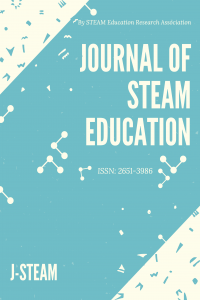Demystifying the ‘Dense’ Problem of Density Using 5E Learning Cycle
Demystifying the ‘Dense’ Problem of Density Using 5E Learning Cycle
The purpose of this action research was in two folds. First, it was to find out the efficacy of the 5E Learning Cycle in improving pupils' understanding of density. And second, to find out whether there will be a significant difference in males and female pupils’ understanding of density after the application of the 5E Learning Cycle. All 36 Basic Six pupils of a Basic School in the Assin North Municipality in the central region of Ghana were purposively selected to participate in the study. Since the design used was action research, the data collection procedure occurred in three stages; Pre-intervention stage, intervention stage and post-intervention stage. The results of the study showed that the mean score for the post-intervention test was almost twice the mean score of the pre-intervention test. While the girls’ scores showed a 111.255% increase, the percentage increase in scores for the boys was 98.676%. However, there was no significant difference between the performance of the boys and girls in the post-intervention test. This study confirmed that by taking pupils through the Engagement, Exploration, Explanation, Elaboration and Evaluation phases of the 5E Learning Cycle, learners will gain an improved understanding of density.
Keywords:
5E learning cycle Density, Science teaching and learning, Inquiry,
___
- Akbulut, H. I., Sahin, C., & Cepni, S. (2012). Effect of using different teaching methods and techniques embedded within the 5E instructional model on removing students’ alternative conceptions: Fluid pressure. Sci. and Tech. Part B-Soc. and Edu Stu, 4, 2403-2414.
- Almuntasheri, S., Gillies, R. M., & Wright, T. (2016). The Effectiveness of a Guided Inquiry-Based, Teachers' Professional Development Programme on Saudi Students' Understanding of Density. Science Education International, 27(1), 16-39.
- Bybee, R. W. 2009. The BSCS 5E Instructional Model and 21st Century Skills. Colorado Springs, CO: BSCS.
- Campbell, M. A. (2006). The effects of the 5e learning cycle model on students’understanding of force and motion concepts (Doctoral dissertation, University of Central Florida Orlando, Florida).
- Dass, P. M. (2015). Teaching STEM Effectively with the Learning Cycle Approach. K-12 STEM Education, 1(1), 5-12.
- Davies, D., & McGregor, D. (2016). Teaching science creatively. Routledge.
- Diyana, T. N., Haryoto, D., & Sutopo. (2020, April). Implementation of conceptual problem solving (CPS) in the 5E learning cycle to improve students’ understanding of archimedes principle. In AIP Conference Proceedings (Vol. 2215, No. 1, p. 050002). AIP Publishing LLC.
- Dole, S., Hilton, G., Hilton, A., & Goos, M. (2013, March). Considering density through a numeracy lens: implications for science teaching. In International Conference New Perspectives in Science Education, Florence (pp. 14-15).
- Duran, L. B., and Duran, E. 2004. “The 5E Instructional Model: A Learning Cycle Approach for Inquiry-Based Science Teaching.” Science Education Review 3(2): 49-58.
- Hashweh, M. Z. (2016). The complexity of teaching density in middle school. Research in Science & Technological Education, 34(1), 1-24.
- Hitt, A. M. (2005). Attacking a dense problem: a learner-centered approach to teaching density. Science Activities, 42(1), 25-29.
- Jensen, J. L., Neeley, S., Hatch, J. B., & Piorczynski, T. (2017). Learning scientific reasoning skills may be key to retention in science, technology, engineering, and mathematics. Journal of College Student Retention: Research, Theory & Practice, 19(2), 126-144.
- Lehesvuori, S., Ramnarain, U., & Viiri, J. (2018). Challenging transmission modes of teaching in science classrooms: Enhancing learner-centredness through dialogicity. Research in Science Education, 48(5), 1049-1069. National Research Council (NRC). (2007). Taking Science to School: Learning and Teaching Science in Grades K-8. Committee on Science Learning, Kindergarten Through Eighth Grade. Richard A. Duschl, Heidi A. Schweingruber, and Andrew W. Shouse, Editors. Board on Science Education, Center for Education. Division of Behavioral and Social Sciences and Education. Washington, DC: The National Academies Press.
- Putra, F., Nur Kholifah, I. Y., Subali, B., & Rusilowati, A. (2018). 5E-Learning Cycle Strategy: Increasing Conceptual Understanding and Learning Motivation. Jurnal Ilmiah Pendidikan Fisika Al-Biruni, 7(2), 171.
- Qazi, H. S., Ashar, A., & Ahmad, S. A. (2019). Impact of an innovative approach of teaching science of dental materials on the learning experiences of undergraduate students. Pakistan Armed Forces Medical Journal, 69(3), 582-88.
- Sarı, U., Hassan, A. H., Güven, K., & Şen, Ö. F. (2017). Effects of the 5E Teaching Model Using Interactive Simulation on Achievement and Attitude in Physics Education. International Journal of Innovation in Science and Mathematics Education, 25(3).
- Serbessa, D. D. (2006). Tension between traditional and modern teaching-learning approaches in Ethiopian primary schools. Journal of International cooperation in education, 9(1), 123-140.
- Steiner, D., & Mendelovitch, M. (2017). I’m the same teacher”: The attitudes of science and computer literacy teachers regarding integrating ICT in instruction to advance meaningful learning. Eurasia Journal of Mathematics, Science and Technology Education, 13(5), 1259-1282.
- Taşlıdere, E. (2015). A study investigating the effect of treatment developed by integrating the 5E and simulation on pre-service science teachers’ achievement in photoelectric effect. Eurasia Journal of Mathematics, Science &Technology Education, 1–16.
- Watkins, J., & Mazur, E. (2013). Retaining Students in Science, Technology, Engineering, and Mathematics (STEM) Majors Journal of College Science Teaching, 42(5) p36-41. Wendel, P., Spoltman, J., & Pochodylo, A. (2019). A Particle Model for Density. Science Scope, 43(2), 55-61.
- ISSN: 2651-3986
- Başlangıç: 2017
- Yayıncı: Şahin İDİN
Sayıdaki Diğer Makaleler
Creating the Science Learning Environment of Secondary School Students’ Dreams
Richard Dein ALTAREZ, Manuel Paolo S AUSTRİA, Joyce Ann L BAYRON, Tristan P PALTONGAN, Reeven J TEOFİLO, Mary Assumptha P SANTİANEZ, Rogel M PODA-AN, Alecxander S IBRADO
Özlem İRVEN AZGIN, Burcu ŞENLER
Demystifying the ‘Dense’ Problem of Density Using 5E Learning Cycle
Sylvester DONKOH, Mıchael KOFI ANNAN, Jennifer OSEİ
Muhammad Dicky DARMAWAN, Siti SYAHRA, Nikki Heherson DAGAMAC
